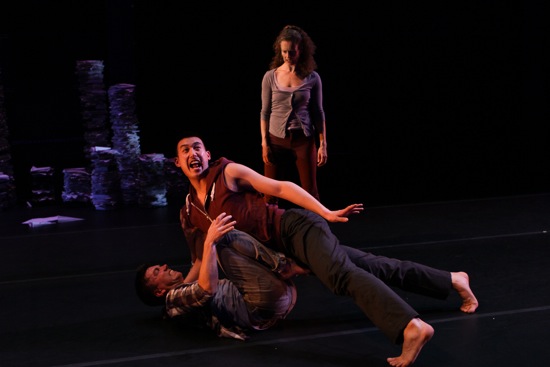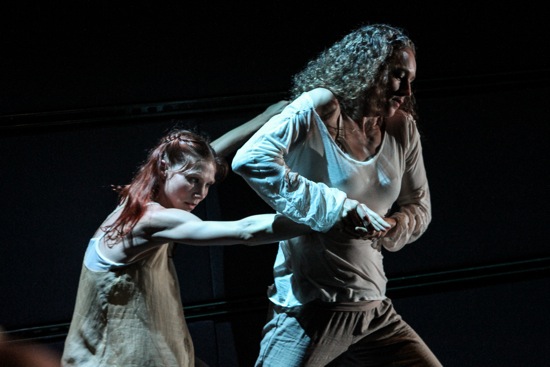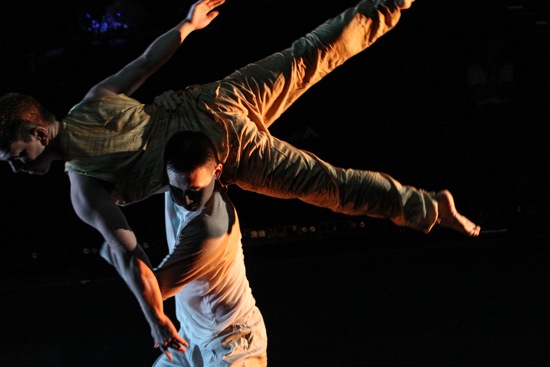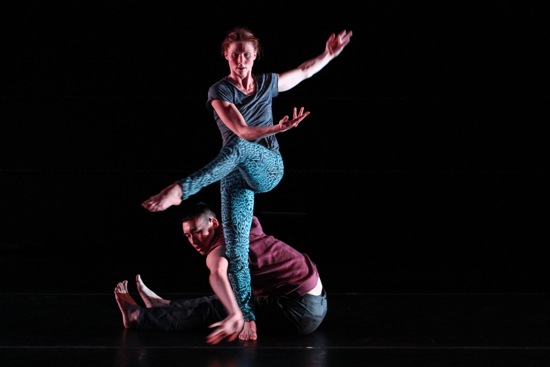The Tiffany Mills Company presents two new works at BAM Fishman.
Remember when dancers rarely talked onstage? No? Then you’re probably still in your twenties. Beginning in the 1980s, when narrative and emotion began to slip back into contemporary American dance and knock its movement-and-form-only stance askew, some choreographers tackled stories that couldn’t be told through dancing alone. Personal narratives, revamped fairy tales, social and political messages—all needed the spoken word. In Tiffany Mills’s Berries and Bulls, her four seasoned performers talk a lot. And what performers! Jeffrey Duval, Kevin Ho, Emily Pope-Blackman, and Petra van Noort are not only gifted dancers, they’re strong actors—delivering text that they, Mills, dramaturge Peter Petralia, and editing advisor Kay Cummings have created. Their truthfulness and lack of affectation can be extremely moving.
Restructured from a 2012 work, with the addition of a cadre of ten guest performers, Berries and Bulls was announced for the Tiffany Mills Company’s BAM Fisher season as a world premiere, along with The Feast (Part 1). The title of the former isn’t much of a clue to its subject. The only berries in evidence are the strawberries eaten by Ho, van Noort and seven of the ten guest performers, as they settle down to hear Pope-Blackman (with three wild-girl, back-up vocalists) sing and yell increasingly harassing commands to Duval, who, draped in a white-feather boa, is attempting to entertain the crowd. At an earlier point, while Duval is continuously butting Pope-Blackman with his chest, she tells him not to act like a bull. Later, there are references to monsters, or possible monsters. After van Noort tries to rouse the recumbent, nestled-together Duval and Ho with the words a mother might use to kids she thinks may be playing dead to tease her, the two men scrabble after her, bellowing and snarling.
Nine diverse musical selections (starting with Janis Joplin singing “Cry Baby”) punctuate most of the talking sections, and Ian Task has created a mysterious set that consists of several variously sized towers made of tattered law books. These cluster in one corner, and a couple of low ones give the performers something to rest on. Paper also figures thematically. As the piece begins, Duval is folding paper airplanes. Later, he’s ordered to sit down and fold some more until he’s calmer. At various times, the little planes are launched or carried across, bearing their multiple allusions to flight, freedom, hobbies, and schoolroom tricks. Duval rolls with one stuck on his nose.

L to R: Jeffrey Duval, Kevin Ho, and Petra van Noort in Tiffany Mills’ Berries and Bulls. Photo: Julie Lemberger
In this world that Mills has created, there are no fixed relationships; we experience Berries and Bulls as a series of incidents that have common qualities. Sometimes the boundary between the four as collaborating dancer-actors working on a project (they address one another by their real names and occasionally issue instructions) and the characters they portray, who may or may not be members of a family, is porous. The ten additional dancers—who occasionally rush in, watch the action, echo or join what the four are doing—convey the idea that Mills wants us to see the issues as universal and the action as shifting as that of a dream.
And what is Mills’s subject? Generally speaking, it’s relationships and the mixed signals we send to our loved ones. She seems to be trying to do something very difficult: to weave a number of emotion-laden strands together with a deliberate elusiveness, so that, together, they can be interpreted in more ways than one. For instance, near the end of Berries and Bulls, a buried story pokes through the texture of desires, thwarted intimacy, and rage. For a few moments, Pope-Blackman and Duval cuddle around Ho like sleepy children, while he speaks dreamily of the starry night, the salty ocean breeze, and a ferris wheel. Suddenly Pope-Blackman awakes. That’s not her memory. She talks of being left alone by him (just for a few minutes, he pleads)—left to lurking monsters, or her terror of them. “I did see you with the bull,” he says inscrutably.
What’s intriguing about Berries and Bulls is also what can be confusing—even maddening—about it: the contrast among the performers’ physical skills, their very adult delivery of the words, and the fact that the words themselves and some of the actions that accompany them suggest children. The exhausted dialogue between Ho and Pope-Blackman seems to be that between a remembered child and her father, but it could well be a scene between a resentful woman and her lover or husband. (While it’s happening, you remember earlier enigmatic words that could allude to this same screw-up on the man’s part.)
The rational and the irrational rub against each other. Sometimes the performers talk matter-of-factly. Sometimes, if they’re moving furiously and talking at the same time, the words come out in yells and gasps. Pope-Blackman dances intensely, as if she’s going through a solo she needs to master, or trying to focus her thoughts. “Don’t touch me,” she says to Ho. He begins charging her dangerously, and she keeps telling him to stop, but as his interference escalates into lifts, she begins to like what’s happening. When they finish, she looks at him and says, ambiguously, “yep.” Duval wants to jump over and over, with Ho’s help. “Higher,” he keeps panting, “higher!” Until Ho puts a stop to it.
Mills comes close to overusing escalation. Repeated actions tend to build in terms of speed and violence; anyone can stop a situation by saying, “cut.” Once, when Pope-Blackman is dancing alone, Ho starts smacking the floor rhythmically with his hand. Faster and harder he hits. Trying to incite her to speed up? Maybe. To assert his control over her? Perhaps. This solo by Pope-Blackman is one of the most imaginative moments of dancing—intense, emotionally fueled, but controlled and variegated, wonderful to watch. In general, the movement is big, hot, and fierce, much of it related to the task at hand: Duval and Ho, scrubbing each other furiously; people tackling one another, yanking a downed adversary by one leg. When the four dance—alone or together—the movement seems to be a metaphor for a common task or desired harmony
There are quieter, tenderer moments—some of them very touching. Duval seems always anxious for approval, for recognition, whether he’s bellicose or forlorn. In fact, there are many powerful episodes in Berries and Bulls. But something about it feels unfulfilled, and at times the text-dancing relationship becomes banal or too obvious, given the enigmatic nature of the whole. I begin to sense little signs of restlessness in the audience, a quiet sigh or two, a shifting of positions. Several times, we expect the piece to end, and it doesn’t. For instance, Duval suddenly tossing sheets of paper into a storm seems like a climactic act, even though it evades easy interpretation. But Mills hasn’t finished yet.

Emily Pope-Blackman (L) and Petra van Noort in Tiffany Mills’ The Feast (Part 1). Photo: Julie Lemberger
Maybe the sheer length of the work is a liability. Too, it comes after The Feast (Part 1), which will eventually acquire a second half. There are no words in this one, but it introduces us to Mills’ interest in physically intense interactions and her ability to construct them. The Feast consists of three duets, set to a compellingly disruptive music composed, performed, and engineered by Jonathan Melville Pratt (one section is for pencil on mat-board, strings, voice, and “variously created synthesizers”).
In the first duet, Mills herself mimes scribbling on the back wall where lighting designer Chris Hudacs has projected an amorphous design that could be bubbles or ghostly faces. Her duet with Ho involves many variations on writing and the erasing of what’s been written. The theme crops up again in a duet for van Noort and Pope-Blackman that takes place on the opposite side of the space. As the women tangle and press together in Hudacs’ suddenly greenish light, van Noort forces Pope-Blackman to “write” on the wall, then bites her hand.
For the encounter between Ho and Duval, Hudacs lights a central area. The two men move closer and closer together until they embrace. Here, Duval draws in air around Ho’s body, and Ho uses his head to trace his companion’s head. Later, they develop a strange image of erasure—Ho rubbing Duval’s back, Duval rubbing Ho’s crotch.
Maybe, in showing the to-be-completed Feast, Mills wanted to introduce us to these remarkably interesting performers before launching Berries and Bulls, but the 90-minute length of the performance (it includes a pause for costume changes and arranging Trask’s set) contributes to the sense that Berries and Bulls loses momentum as it wanders through its too-well-stocked storehouse of pungent episodes.


